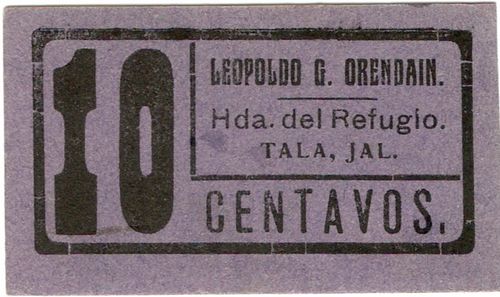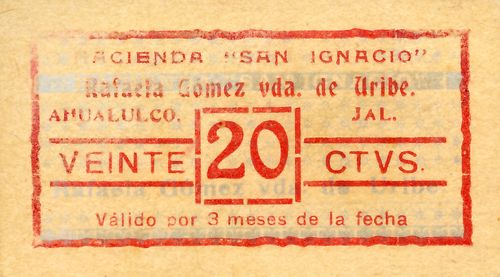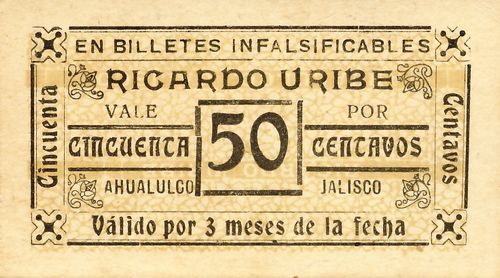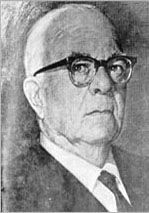Printers in Guadalajara
Ancira Hermanos
Mariano Rodríguez set up a lithograph and printing workshop in 1820, which was passed on to his son, Dionisio Rodríguez, and then to the brothers Modesto and Gonzalo Ancira GonzálezGonzalo was born in Monclova, Coahuila in 1849 and died in Guadalajara on 5 January 1913: Modesto was born in Monterrey, Nuevo León in 1854 and died in Guadalajara on 10 February 1913, who had joined the firm when they came from Nuevo León in 1865. The business introduced lithographic art to Guadalajara, producing works that won awards in national and foreign exhibitions. Their expert lithographer was Teofilo Loreto.
From 1883 the printshop was known as "Tipografía y Litografía de Loreto y Ancira y Cia." or "Ancira y Hermano". In 1919 when Loreto died his son Francisco dissolved the partnership. The printers continued operating until bad management and a strike caused it to fail in 1936
It was located at Santo Domingo núm. 13 (today Avenida Alcalde núm. 113), on the corner of calle Juan Manuel.
José María Iguíniz
José María Iguíniz Alcala was another printer in Guadalajara.
Military issues
His first foray into producing paper currency was in April 1914 to quote for a provisional Huertista issue in Colima, though that contract was given to a Mexico City firm. In August 1914 he produced a series of three cartones for Manuel Diéguez’s Dirección General de Rentas in Guadalajara and a similar issue in Colima.
In November 1914 his firm produced the second issue of notes for Durango’s Domingo Arrieta, copied from Arrieta’s first issue and in January 1915 another issue for Diéguz, with the title ‘EJERCITO CONSTICIONALISTA – DIVISION DE OCCIDENTE’.
In June 1915 he produced another issue for Colima.
Private issues
Iguíniz produced notes for haciendas and private businesses.
The earliest might be a set of notes for the Negociación Minera de San Rafael y Anexas, dated April 1914.
Since these notes usually did not carry a printer’s imprint it is harder to assign them but we can detect some common designs which would suggest a single printer and timeframe (and can occasionally be linked to a note with a printer’s imprint).

One set of issues has a large numeral on the left and the issuer in a box in the top right. These include the Hacienda del Refugio, of Leopoldo G. Oredain, in Tala and the Aserradero de Taxinastta, of Angel Arch hijo, in Tuxpanthe, both attributed to Iguíniz, so we can add the Hacienda de Telcampana, of Jacinto Cortina, in Sayula;. A (subsequent) subset adds an underprint with the issuer's name, such as the Hacienda de la Esperanza, of Jesús Odilón Cañedo, in Ameca.

Another set has a design with the denomination in a central box and are also time-limited, suggesting that they were a response to a shortage of small change which was expected shortly to be remedied. This includes the Hacienda de Santa Cruz in Ahualulco. A subset again has the issuer’s name in the underprint: the Fraccionamiento de la Hacienda “La Esperanza” in Ameca, and the Hacienda “San Ignacio” of Rafaela Gómez, of Ahualulco.

Ricardo Uribe, also in Ahualulco, and the Hacienda “El Naranjo y Anexas”, in Pihuamo, were redeemable in infalsificables, whilst the Hacienda de Guaracha, in Villamar, Michoacán, also, like El Naranjo owned by the heirs of Diego Moreno, had a date of 16 September 1915.
The Gran Cantina y Hotel Anguiano, in Ciudad Guzmán, also used the underprint but with a slightly different design and not in cash or time-limited.
Other hacienda issues were simpler ones for El Cuis, San Miguel and two different isues for the Hacienda de Estipac.
More ornate were circular cartones for the Fábrica de San José de Refugio, and a $1 note for the Empresa de Desagüe de la Laguna de la Magdalena in Tacátzcuaro, Michoacán, also redeemable in infalsificables.
Juan Kaiser
Juan Kaiser Schwab was born in Leusigen, Switzerland in 1858, and in 1881, at the age of twenty-three, sought his fortune in South America, travelling from Chile to Bolivia and from Peru to Panama. In 1887 he settled in Mexico City, and was employed by the stationers “La Helvetía”. At the end of that year, with his elder brother Arnoldo, he acquired a bookshop, “Al Libro Mayor”, in San Luis Potosí. In 1899 he moved to Guadalajara and founded “Al Libro de Caja,” dealing in printing, binding, office stationery and books in general. The Kaiser brothers were instrumental in introducing the picture postcard to San Luis Potosí and, probably, Guadalajara. Juan Kaiser died in 1916, and was succeeded by his son, Javier, who in time handed the business over to its employees and went to live in Switzerland, his ancestral home.
John Kaiser Schwab was born in Leusigen, Switzerland in 1858, to John Kaiser and Elizabeth Schwab. In 1881, at the age of twenty-three, he embarked for America in search of fortune, on a strange path that took him from Chile to Bolivia and from Peru to Panama. At the beginning of 1887 he was already living in Mexico City, as an employee of the "La Helvetia" stationery store, of his compatriot Guillermo Kaiser and his partner Luis Martín. The shop specialized in "foreign papers and envelopes, stationery and school supplies”.
At the end of 1887, with his elder brother Arnoldo, he acquired a bookshop, “Al Libro Mayor”, Antonia Reynoso's bookstore in San Luis Potosí.
In 1899 he moved to Guadalajara and founded "Al Libro de Caja" at calle San Francisco núm. 147, at the corner with calle López Cotilla, in the premises where the firm of Blume y Compañía had previously been. The store dealt in typographic printing, binding, blank books and books in general. Kaiser established his private home at calle El Carmén (today, Avenida Juárez), núm. 52.
The record of the first illustrated postcard in Mexico dates back to 1896 and the Kaiser brothers were instrumental in introducing the picture postcard to San Luis Potosí and, probably, Guadalajara. Two of the company's postcards were provided by the Banco de Jalisco to the American Bank Note Company as models for new vignettes.
Juan Kaiser died in 1916, and was succeeded by his son, Javier, who in time handed the business over to its employees and went to live in Switzerland, his ancestral home.
Among Juan Kaiser's clients in Guadalajara were the owners and administrators of many agricultural and livestock farms in Jalisco and beyond, who also had him make vales to be used in the payment of salaries. The scarcity of fractional currency during the revolutionary era favored this type of order, although the haciendas of Western Mexico had a small number of labourers compared to the henequen haciendas or coffee plantations of the southeast of the republic, which employed thousands of workers.
Ricardo Delgado, author of Las Monedas Jaliscienses durante la Epoca Revolucionaria, obviously had access to Juan Kaiser’s records and gives detailed listings of the issues for Jalisco. The earliest are ration tokens for the Hacienda de San Juan de los Arcos in November 1913, whilst true ‘currency’ dates from January 1914. These notes are of thick paper or, more often, pressboard and there are a few common designs, most noticeably the round cartón with the denomination on the face and the same in Roman numerals (and often the hacienda’s brand) on the reverse. They usually carried the imprint “J.K.G” (for Juan Kaiser Guadalajara) or some variation, and the number of the order (modelo) which allows the various issues to be dated.
Font y Velasco
This company's imprint is on just one issue, for a restaurant in the same street.
 Leopoldo Font Riudor was born on 13 February 1879 in Mexico City, where he lived until his youth and then followed his father through Spain and Argentina. He came to Guadalajara to work with his uncle at the “La Enseñanza” bookstore. Later he left there and joined Manuel Velasco with whom he founded, in 1908, with Manuel Velasco, the bookshop Font y Velasco, at number twelve on Avenida Colón. The store offered a bookstore, stationery, printing, bookbinding and book publishing service (librería, papelería, imprenta, encuadernación y edición de libros). In the following years, due to the difficult times of the revolution, Leopoldo moved to Spain where he settled his wife and his first two children He travelled to Argentina to work for an American company, and when he had enough money he was able to pay for his family's trip to Argentina, where the third of his children was born. Also in that country he learned of the death of his partner Velasco and in 1918 he returned to Guadalajara and changed the name of the business to Librería de Leopoldo Font. The bookstore soon became a kind of athenaeum where intellectuals of diverse social, economic and political opinions met on Thursday and Saturday afternoons to discuss the novelties that arrived at the bookstore and cultural issues in general.
Leopoldo Font Riudor was born on 13 February 1879 in Mexico City, where he lived until his youth and then followed his father through Spain and Argentina. He came to Guadalajara to work with his uncle at the “La Enseñanza” bookstore. Later he left there and joined Manuel Velasco with whom he founded, in 1908, with Manuel Velasco, the bookshop Font y Velasco, at number twelve on Avenida Colón. The store offered a bookstore, stationery, printing, bookbinding and book publishing service (librería, papelería, imprenta, encuadernación y edición de libros). In the following years, due to the difficult times of the revolution, Leopoldo moved to Spain where he settled his wife and his first two children He travelled to Argentina to work for an American company, and when he had enough money he was able to pay for his family's trip to Argentina, where the third of his children was born. Also in that country he learned of the death of his partner Velasco and in 1918 he returned to Guadalajara and changed the name of the business to Librería de Leopoldo Font. The bookstore soon became a kind of athenaeum where intellectuals of diverse social, economic and political opinions met on Thursday and Saturday afternoons to discuss the novelties that arrived at the bookstore and cultural issues in general.
Leopoldo Font Riudor was a man with a very broad culture, he had a calm, gentle character, he did not use scolding towards his employees because he considered it a humiliation and towards customers he always had a cordial attitude.
He died on 4 August 1963.
